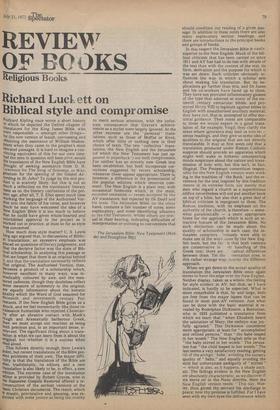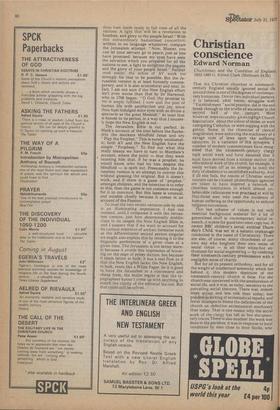REVIEW OF BOOKS
Religious Books
Richard Luc' ett on Biblical style and compromise
!4rdyard Kipling once wrote a short history in which he depicted the Oxford chapter of translators for the King James Bible, who Were responsible — amongst other things— for the new version of Isaiah, canvassing and Obtaining the assistance of William Shakespeare when they came to the prophet's most elevated passages. It is hard to imagine a convincing equivalent of this for our own time: had the men in question still been alive, would the translators of the New English Bible have thought of seeking assistance from D. H. Lawrence for The Song of Solomon, or Wittgenstein for the opening of the Gospel According to St. John? To judge by the end product it is scarcely likely, but this is not so Much a reflection on the translators' literary taste as on the literary confusions of the present age; after all, T. S. Eliot spent much time Working the language of the Authorised Version into the fabric of his verse, and however rnuch he may have welcomed the idea of a New English Bible it is too much to believe that he could have given whole-hearted and Uninhibited approval to the project as it Worked out in practice, at least so far as style W as concerned.
, How much does style matter? C. S. Lewis long ago argued that, in discussions of Biblical translations, an excessive emphasis was Placed on questions ofliteraryjudgement, and that the decisive factor was the state of Biblical scholarship. In analysing this passage or that,we forget that there is an original behind It, and that the translation necessarily reflects Plat original. The Authorised Version, then, however a product of a scholarship which, nowever excellent in many ways, was ineradicably coloured by awe, and the meaSured cadences, though they doubtless reflect aorne measure of symmetry in the original, are equally informative about the hieratic quality which the Word. of God assumed for siXteenth and seventeenth century Protestants. If the New English Bible gives us a Shock, and we feel momentarily like those reriaissance humanists who rejected Christianity after an abrasive contact with Mark's rough and Aramaically barbarous Greek, ,then we must accept our reaction as being ooth precious and, in an important sense, ir,relevant. The significant thing about a translation is what we can learn from it about the original, not whether it is a success when read aloud.
This follows directly enough from Lewis's Point, but recent translations of the Bible present problems of their own. The major difficulty is that the translators of the Bible are also, traditionally, its editors, and a new translation is also likely to be, in effect, a new edition. The extreme case of the translation editor is provided by Robert Graves, who in his Nazarene Gospels Restored offered a reconstruction of the earliest versions or' the §asic Christian documents. The result, which is drastic, provocative and amusing, was regarded with some justice as being too cranky
to merit serious attention, with the unfornate consequence that Graves's achievements as a stylist were largely ignored. At the other extreme are the ' personal ' translations, such as those of Moffat or Knox, which offer little or nothing new in their choice of texts. The two 'collective' translations, the New English and the Jerusalem (of which the New Testament has just appeared in paperback') are both compromises. For neither has an entirely new Greek text been established, but both incorporate corrections suggested by recent scholarship, whenever these appear appropriate. There is, however, a difference in the presentation of the popular editions which deserves comment. The New English is a plain text, with occasional footnotes which, in the main, recorded omissions — verses accepted by the AV translators, but rejected by Dr Dodd and his team. The Jerusalem Bible, on the other hand, contains a fair number of notes, some explanatory, and some identifying allusions to the Old Testament, whilst others are textual in their bearing, indicating difficulties of interpretation or pointing to conventions that should condition our reading of a given passage. In addition to these notes there are also many explanatory section headings, and there are introductions to the principal books and groups of books.
In this respect the Jerusalem Bible is vastly superior to the New English. Much of the biblical criticism that has been carried on since 1611 and AV has had to do less with details of the text than with the context of the text, its form, derivation and the purpose for which it was set down. Such criticism obviously influences the way in which a scholar sets about making his translation. But its implications go further than this, and Dr Jones and his co-workers have faced up to them. They have not provided inflammatory glosses of the type that adorned so many of the sixteenth century vernacular bibles, and prompted Henry VIII to legislate against bibles in English with unauthorised ancillary material; they have not, that is, attempted to offer doctrinal guidance. Their notes are comparable to those we would expect in a good translation of, for example, Virgil; they clarify the areas where ignorance may lead us into en neous readings, and they give us some idea of qualities in the original that are not directly translatable. It may at first seem odd that a translation produced under Roman Catholic auspices should provide an apparatus which might well wake in hitherto unsuspecting minds suspicions about the nature and transmission of holy writ, but this isn't, in fact, illogical. The Protestant consortium responsible for the New English version were working in the tradition of 'the Book,' and the reverence for the text inspired by this tradition means in its extreme form, not merely that men who regard a church as a superstitious , edifice nevertheless will not put another book on top of a bible, but also that a great deal of biblical criticism is repugnant to them. The Roman tradition, with its emphasis on the authority of the church, is therefore — somewhat paradoxically — a more appropriate home for the approach which is such an attractive feature of the Jerusalem Bible. No such distinction can be made about the quality of scholarship in each case; the Jerusalem compilers hviously were able to make use of the work done by the New English team, but the fat* is that both versions are conservative in eir handling of the Greek text; there are radical differences
between them. Yet the ,tsentation does, in this rather strange way, display the different approach.
When we get down to the actual quality of translation the Jerusalem Bible once again seems to have the edge over the New English. Neither display, taken as a whole, the feeling for style evident in AV, but that, as I have indicated, is hardly to be expected. What is more remarkable is that, by and large, both are free from the major lapses that can be found in most post-AV versions. Just what can be done with the basic material is revealed by Rodolphus Dickinson, a Bostonian, who in 1833 published a translation from which we learn that "when Elizabeth heard the salutation of Mary, the embryo was joyfully agitated." This Dickinson considered more appropriate, at least for " accomplished and refined persons," than "the babe leaped in her womb." The New English tells .us that "the baby stirred in her womb." The Jerusalem has "the child leaped in her womb." The last seems a very satisfactory reading, getting rid of the archaic ' babe,' avoiding the nursery quality of "baby," and equally avoiding the mild but unfortunate ambiguity of "stirred " — which is also, as it happens, a shade archaic. The failings evident in the New English are absolutely characteristic, as we discover if we move on to the Nunc dimittis, Here the New English version reads: "This day, Master, thou givest thy servant his discharge in peace; now thy promise is fulfilled. For I have seen with my own eyes the deliverance which thou hast made ready in full view of all the nations: A light that will be a revelation to 'heathen, and glory to thy people Israel." With this extraordinary bastardised concoction, written in no language whatsover, compare the Jerusalem attempt: " Now, Master, you can let your servant go in peace, just as you have promised: because my eyes have seen the salvation which you prepared for all the nations to see, a light to enlighten the pagans and the glory of your people Israel." Neither read easily; the echos of AV work too strongly for that to be possible. But the Jerusalem version is at least honestly contemporary, and it is also economical and neat. In fact, I am not sure if the New English effort isn't even worse than that by Dr Harwood, who in 1768 began: "0 God, thy promise to me is amply fulfilled. I now quit the post of human life with satisfaction and joy, since thou hast indulged mine eyes with so divine a spectacle as the great Messiah." At least that is honest to its period, in a way that I sincerely hope the New English is not.
The Jerusalem Bible is not perfect. In Mark's account of the trial before the Sanhedrin the mockers blindfold Jesus and cry " Play the Prophet." This is surely unidiomatic; both AV and the New English have the simple "Prophesy." To find out what this really means we have to turn to Matthew's account, where the point — that they were taunting him that, if he was a prophet, he would know who had hit him despite the blindfold — is spelt out. Presumably the Jerusalem version is an attempt to convey this without glossing the original. But it doesn't. work, and if there is a game of ' prophet ' amongst children, and the intention is to refer to this, then the game is not common enough for it to convince. But this lapse is unusual, and notable chiefly because it comes in an account of the Passion.
To read the two recent versions side by side is an illuminating experience. I had not realised, until I compared it with the Jerusalem version, just how determinedly middleclass in its usages the New English Bible is, and I suspect that if we want to account for its curious retention of archaic formulae such as the differentiated second person singular we might also explain this by relating it to the linguistic preferences of a given class at a given time. The Jerusalem is not better merely because it avoids this impression of hovering on the edge of prissy diction, but because it reads better in bulk; it has a real flow to it that the New English lacks; the New English, in bulk, reads like a White Paper. So it is good to have the Jerusalem in a convenient and cheap form; the major regret is that the typographers haven't come up with anything to match the clarity of the editorial lay-out. But that could still be solved.































 Previous page
Previous page